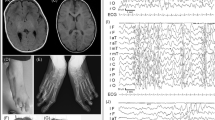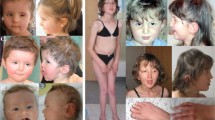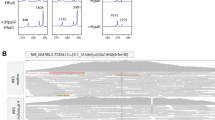Abstract
Caspr2 is a member of neurexin superfamily, members of which are transmembrane proteins that mediate cellular interactions in the nervous system. Recently, truncation of the CNTNAP2 gene coding for the Caspr2 protein has been suggested to be associated with the Gilles de la Tourette syndrome, a neurological disorder characterized by motor and vocal tics, and behavioral anomalies. In this study, we describe a familial balanced reciprocal translocation t(7;15)(q35;q26.1) in phenotypically normal individuals. The 7q35 breakpoint disrupts the CNTNAP2 gene, indicating that truncation of this gene does not necessarily lead to the symptoms of the complex Gilles de la Tourette syndrome.
Similar content being viewed by others
Introduction
CNTNAP2 encodes contactin-associated protein-like 2 (Caspr2), which is localized to the juxtaparanodal regions at the node of Ranvier of myelinated axons.1 Caspr2 is colocalized and physically associated with Shaker-type voltage-activated K+ channels (Kv1).2 Studies with Caspr2-null mice suggest that Caspr2 is necessary for localization and/or maintenance of Kv1 channels.3 The CNTNAP2 gene resides at 7q35-q36.1 and consists of 25 exons, covering an approximately 2.3-Mb genomic region (Figure 1a). Representing 1.5% of chromosome 7, it is one of the largest genes in the human genome.4
(a) Schematic representation of the two chromosome breakpoints truncating the CNTNAP2 gene. The white bar indicates the breakpoint region described by Verkerk and colleagues6 in a GTS patient with inv(2)(p23q22),ins(7;2)(q35-q36;p21p23) and the black bar indicates the breakpoint region of the present case with t(7;15). The horizontal line represents the genomic region covered by the gene and the vertical lines represent the exons; (b) The pedigree of the t(7;15)(q35;q26.2) translocation family. N, normal karyotype; filled symbol, unbalanced translocation 46,XY/XX,der(7)t(7;15)(q35;q26.2); symbol with dot, translocation carrier. Arrow indicates the index case.
Mutations in CNTNAP2 have been associated with two distinct neurological disorders: cortical dysplasia-focal epilepsy syndrome (CDFE, OMIM 610042)5 and Gilles de la Tourette syndrome (GTS, OMIM 137580).6 CDFE is characterized by cortical dysplasia, focal epilepsy, relative macrocephaly, and diminished deep-tendon reflexes. Homozygous frame-shift mutations of CNTNAP2 have been detected in CDFE patients in the Old Order Amish community. Heterozygotes did not present symptoms, suggesting a recessive condition.5 GTS is a chronic neuropsychiatric disorder characterized by intermittent and involuntary motor and vocal tics beginning in childhood.7 This phenotype is associated frequently with behavioral, emotional and cognitive problems that are often more incapacitating than the tics. GTS is a complex disorder with a strong heritable component.8 Sequence variations of SLITRK1 have been detected in a few GTS patients,9 but the genetic component in most GTS cases is yet unknown. In a family with a complex chromosome rearrangement, the CNTNAP2 gene was truncated by one of the breakpoints in family members with GTS and CNTNAP2 was therefore suggested to be a candidate gene for this disorder6 (Figure 1a).
In this study, we describe a three-generation family with a balanced t(7;15) translocation. The chromosome 7q breakpoint disrupts the CNTNAP2 gene, but the translocation carriers do not present clinical features of GTS.
Materials and methods
Cytogenetic analyses, FISH and CGH
Metaphase chromosomes were obtained from peripheral blood lymphocytes and the karyotype of the patient was determined by G-banding. Fluorescence in situ hybridization (FISH) was performed using bacterial artificial chromosome (BAC) clones from the RPCI-11 library (Human Genome Browser) according to standard procedures. High-resolution comparative genome-hybridization (CGH) was carried out as described previously.10
Results and discussion
The family presented in this study (index case III;2, Figure 1b) was detected through a systematic re-examination of balanced reciprocal translocation carriers in Denmark.11 The family history revealed that the translocation in the family was first recognized after the birth of a boy (V;1) with multiple congenital malformations and an unbalanced karyotype, 46,XY,der(7)t(7;15)(q35;q26.2) (Figure 1b). Cytogenetic analyses showed that his father (IV;2), grandmother (III;2) and great grandfather (II;1) were all carriers of an apparently balanced translocation with the karyotype 46,XX/XY, t(7;15)(q35;q26.2). Subsequently IV;4 was investigated and she was shown to be carrier of the same unbalanced translocation as found in V;1 (Figure 1b). IV;4 had multiple malformations, severe mental retardation and did not have any language development. She had scoliosis and could take only a few steps with support, but otherwise could not walk. She had a single kidney, hearing loss, ptosis and vision loss because of cataract and affected optic nerve. She did not have any sense of hunger and therefore she was fed through a tube. She had a cheerful and extrovert personality. She died at the age of 34 years. The other patient (V;1) with the same unbalanced translocation is presently 16 years old; he also has multiple congenital malformations, severe mental retardation, no language development and scoliosis. However, he cannot walk even with support. He has myopia, otherwise his vision is normal. He has an introverted personality. The index case (III;2) had hypermetropia and she developed pre-eclampsia during her second gestation. All the balanced translocation carriers were otherwise phenotypically normal. None of the balanced translocation carriers showed any signs of GTS, assessed according to the DSM-IV diagnostic criteria.
FISH analyses of the balanced translocation carrier III;2 using BAC clones from the RPCI-11 library (Human Genome Browser) revealed that the chromosome 7q breakpoint was within the BAC clone RP11-162a9, which is located entirely within the genomic region covered by the CNTNAP2 gene. The closest non-spanning proximal BAC clones were RP11-945o17 and RP11-291n9, and the closest non-spanning distal BAC clones were RP11-688o16 and RP11-641c20. The breakpoint was thus localized to a region of approximately 21-kb (chromosome position, 146.839.903–146.861.494. Human Genome Browser, March 2006 Assembly) within intron 11 of the CNTNAP2 gene (Figure 1a).
The 15q26.1 breakpoint was within the overlapping region of three BAC clones RP11-231p17, RP11-78b3, and RP11-296i21. This breakpoint was localized to an approximately 90 kb region (chromosome position, 91,713,990–91,805,103, Human Genome Browser) within a hypothetical gene (AK094352). CGH analysis did not reveal loss or gain of any chromosome region (data not shown).
A homozygous mutation of CNTNAP2 has been associated with CDFE in the Old Order Amish community,5 but it is unknown whether CNTNAP2 mutations result in CDFE in other populations. However, the present case supports the finding that disruption of a single allele of CNTNAP2 does not lead to CDFE, in line with the suggested recessive-inheritance.5
Verkerk and colleagues6 suggested CNTNAP2 as a candidate gene for GTS based on the finding of a truncating chromosome breakpoint (Figure 1a). The authors hypothesized that disruption of CNTNAP2 would lead to decreased gene expression, which in turn would affect localization and/or maintenance of Kv1 channels. This would influence conduction and/or re-polarization of action potentials in certain brain regions sensitive to these changes, resulting in a diminished inhibition of unwanted tics as observed in GTS. The absence of GTS symptoms in the present translocation family indicates that disruption of CNTNAP2 does not necessarily lead to GTS. However, taking into consideration the complex etiology of GTS with a probable polygenic character, this finding does not strictly exclude the involvement of Caspr2 in GTS pathogenesis.
References
Rasband MN : It's ‘juxta’ potassium channel!. J Neurosci Res 2004; 76: 749–757.
Poliak S, Gollan L, Martinez R et al: Caspr2, a new member of the neurexin superfamily, is localized at the juxtaparanodes of myelinated axons and associates with K+ channels. Neuron 1999; 24: 1037–1047.
Poliak S, Salomon D, Elhanany H et al: Juxtaparanodal clustering of Shaker-like K− channels in myelinated axons depends on Caspr2 and TAG-1. J Cell Biol 2003; 162: 1149–1160.
Nakabayashi K, Scherer SW : The human contactin-associated protein-like 2 gene (CNTNAP2) spans over 2 Mb of DNA at chromosome 7q35. Genomics 2001; 73: 108–112.
Strauss KA, Puffenberger EG, Huentelman MJ et al: Recessive symptomatic focal epilepsy and mutant contactin-associated protein-like 2. New Eng J Med 2006; 354: 1370–1377.
Verkerk AJMH, Mathews CA, Joosse M et al: CNTNAP2 is disrupted in a family with Gilles de la Tourette syndrome and obsessive compulsive disorder. Genomics 2003; 82: 1–9.
American Psychiatric Association: Diagnostic and Statistical Manual of Mental Disorders, Fourth Edition (DSM-IV), Washington DC, 1994.
Pauls DL : Update on the genetics of Tourette syndrome. Adv Neurol 2001; 85: 281–293.
Abelson JF, Kwan KY, O'Roak BJ et al: Sequence variants in SLITRK1 are associated with Tourette's syndrome. Science 2005; 310: 317–320.
Kirchhoff M, Gerdes T, Rose H, Maahr J, Ottesen AM, Lundsteen C : Detection of chromosomal gains and losses in comparative genomic hybridization analysis based on standard reference intervals. Cytometry 1998; 31: 163–173.
Bache I, Hjorth M, Bugge M et al: Systematic re-examination of carriers of balanced reciprocal translocations: a strategy to search for candidate regions for common and complex diseases. Eur J Hum Genet 2006; 14: 410–417.
Acknowledgements
We are grateful to the family for their cooperation. We thank Minna Becher, Karen Friis Henriksen, Anita Niebuhr, Kirsten Winther for their skillful technical assistance. Wilhelm Johannsen Centre for Functional Genome Research is established by The Danish National Research Foundation.
Author information
Authors and Affiliations
Corresponding author
Additional information
Online information
Online Mendelian Inherance in Man (OMIM) (http://www.ncbi.nlm.nih.gov/entrez/query.fcgi?db=OMIM).
Human Genome Browser, UCSC genome bioinformatics (http://genome.ucsc.edu/cgi-bin/hgGateway).
Rights and permissions
About this article
Cite this article
Belloso, J., Bache, I., Guitart, M. et al. Disruption of the CNTNAP2 gene in a t(7;15) translocation family without symptoms of Gilles de la Tourette syndrome. Eur J Hum Genet 15, 711–713 (2007). https://doi.org/10.1038/sj.ejhg.5201824
Received:
Revised:
Accepted:
Published:
Issue Date:
DOI: https://doi.org/10.1038/sj.ejhg.5201824
Keywords
This article is cited by
-
Cryptic breakpoint identified by whole-genome mate-pair sequencing in a rare paternally inherited complex chromosomal rearrangement
Molecular Cytogenetics (2018)
-
Candidate Genes for Inherited Autism Susceptibility in the Lebanese Population
Scientific Reports (2017)
-
Phenotypic subregions within the split-hand/foot malformation 1 locus
Human Genetics (2016)
-
Gilles de la Tourette syndrome is not linked to contactin-associated protein receptor 2 antibodies
Molecular Brain (2015)
-
Shining a light on CNTNAP2: complex functions to complex disorders
European Journal of Human Genetics (2014)




